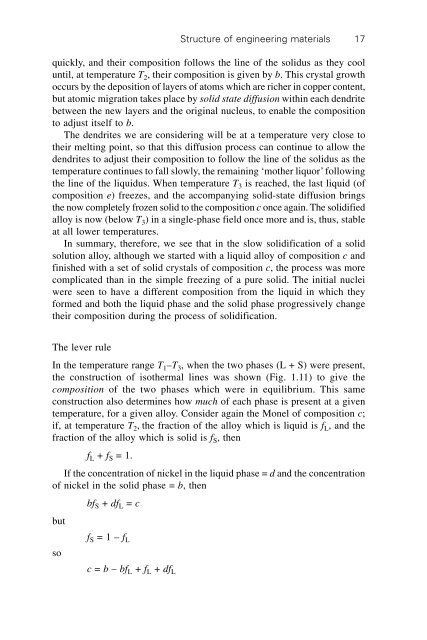Materials for engineering, 3rd Edition - (Malestrom)
You also want an ePaper? Increase the reach of your titles
YUMPU automatically turns print PDFs into web optimized ePapers that Google loves.
Structure of <strong>engineering</strong> materials 17<br />
quickly, and their composition follows the line of the solidus as they cool<br />
until, at temperature T 2 , their composition is given by b. This crystal growth<br />
occurs by the deposition of layers of atoms which are richer in copper content,<br />
but atomic migration takes place by solid state diffusion within each dendrite<br />
between the new layers and the original nucleus, to enable the composition<br />
to adjust itself to b.<br />
The dendrites we are considering will be at a temperature very close to<br />
their melting point, so that this diffusion process can continue to allow the<br />
dendrites to adjust their composition to follow the line of the solidus as the<br />
temperature continues to fall slowly, the remaining ‘mother liquor’ following<br />
the line of the liquidus. When temperature T 3 is reached, the last liquid (of<br />
composition e) freezes, and the accompanying solid-state diffusion brings<br />
the now completely frozen solid to the composition c once again. The solidified<br />
alloy is now (below T 3 ) in a single-phase field once more and is, thus, stable<br />
at all lower temperatures.<br />
In summary, there<strong>for</strong>e, we see that in the slow solidification of a solid<br />
solution alloy, although we started with a liquid alloy of composition c and<br />
finished with a set of solid crystals of composition c, the process was more<br />
complicated than in the simple freezing of a pure solid. The initial nuclei<br />
were seen to have a different composition from the liquid in which they<br />
<strong>for</strong>med and both the liquid phase and the solid phase progressively change<br />
their composition during the process of solidification.<br />
The lever rule<br />
In the temperature range T 1 –T 3 , when the two phases (L + S) were present,<br />
the construction of isothermal lines was shown (Fig. 1.11) to give the<br />
composition of the two phases which were in equilibrium. This same<br />
construction also determines how much of each phase is present at a given<br />
temperature, <strong>for</strong> a given alloy. Consider again the Monel of composition c;<br />
if, at temperature T 2 , the fraction of the alloy which is liquid is f L , and the<br />
fraction of the alloy which is solid is f S , then<br />
f L + f S = 1.<br />
If the concentration of nickel in the liquid phase = d and the concentration<br />
of nickel in the solid phase = b, then<br />
bf S + df L = c<br />
but<br />
so<br />
f S = 1 – f L<br />
c = b – bf L + f L + df L



